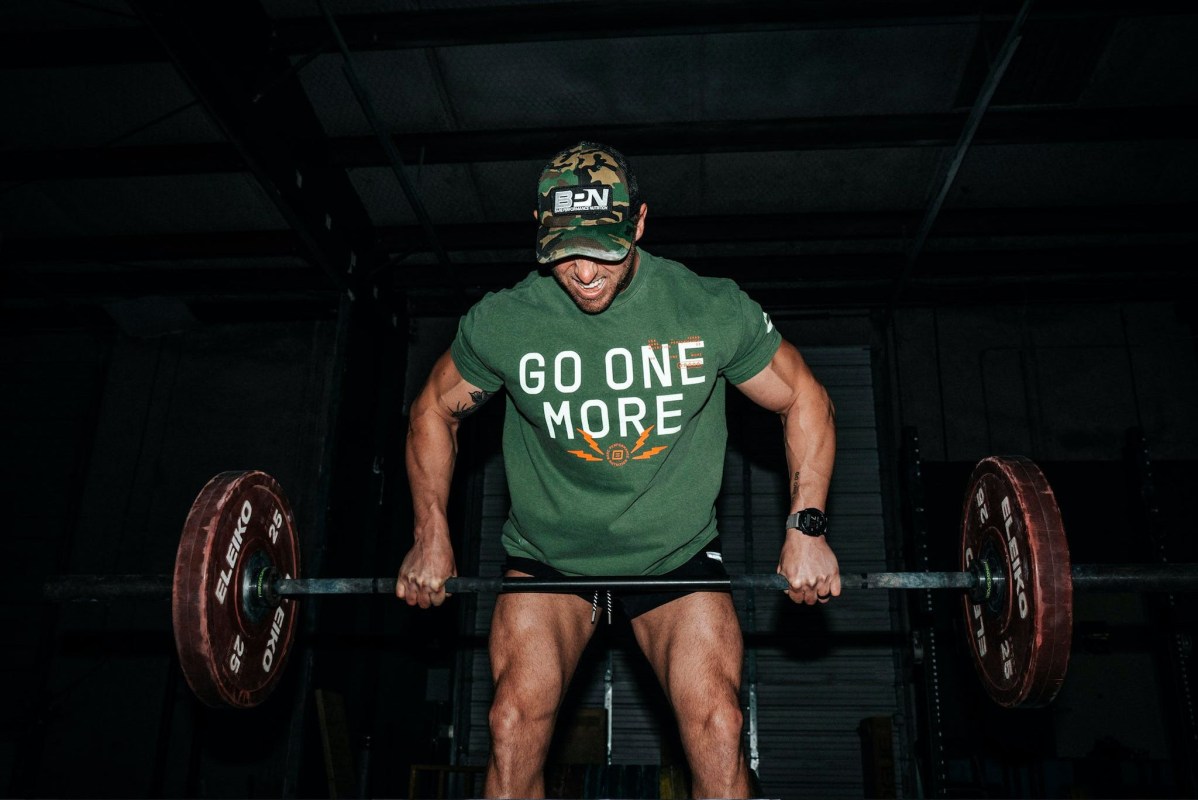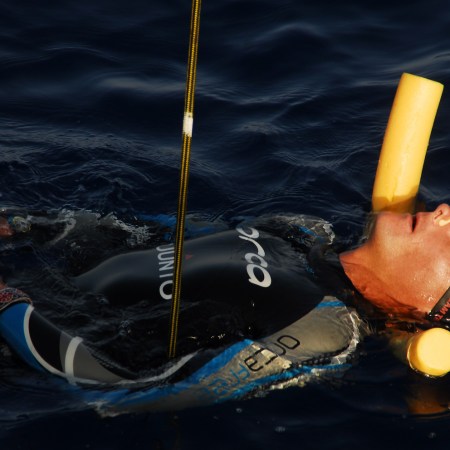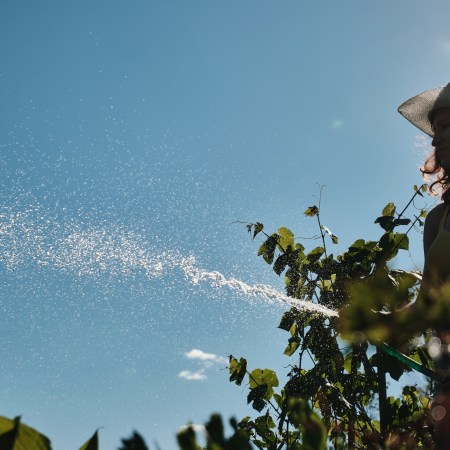Nick Bare is a former Infantry Platoon Leader who was stationed at Fort Hood, Texas, before transitioning out to build his supplement brand Bare Performance Nutrition.
Over the course of the last decade, Bare’s been at the forefront of the “fitness range” movement — he’s the rare bodybuilder who also runs ultramarathons. Bare transformed himself into a hybrid athlete with gut-punching training sessions and constant self-experimentation, first in military tests, like U.S. Ranger School, and then as a civilian, by signing up for the most extreme races in the world.
We spoke with Bare about the lifelong lessons he learned in the military, the pillars of the hybrid athlete lifestyle and BPN’s famous battle cry: “Go One More.”
What was your introduction to the military, and what made you want to enlist?
My dad’s side of the family are dairy farmers, and my mother’s side were military. My uncle and my cousin were Army, and my grandfather was in the Air Force. I remember right before I graduated high school I saw my cousin go into the Army and have this transformation from a boy to a man. He was in the 101st Airborne Division and was serving when deployments to Iraq were very kinetic.
I saw him come back as this man who had these experiences and tools that were helping him become a true warrior. I wanted that same experience. That’s why I decided to go for a military scholarship and education, followed with going into active duty. I wanted to serve, and it felt right to serve, but selfishly I also wanted that improvement for myself.
There’s a physical requirement that comes with serving in the military. Did you have a strong baseline when you entered your ROTC scholarship?
I was diagnosed with a severe eating disorder when I was 14 years old. There was a control I felt by getting thinner and thinner, to an unhealthy level. I was essentially starving myself and was in and out of the hospital. I had an extremely horrible relationship with food. I struggled with it for three years, until I was 17 and on my way out of high school.
In the end I used fitness, and eating for nutrition, as a way to start to fix those issues. I was able to see what I was capable of when I was eating better. That’s when I knew that I wanted to study nutrition at Indiana University of Pennsylvania with my Army ROTC scholarship. I started to take that negative and turn it into a positive. I wanted to understand sports performance, body composition and ways to help people get more powerful.
How to Improve Your “Fitness Range”
Hybrid athletes pump up their hearts and biceps in equal measureWhat was it like coming out of college and going straight into the Army?
I graduated college in 2013 and I went right into the Army after, spending a year at Fort Benning in Georgia. During that next year I was in the infantry school, the ranger school, the airborne school, and at the conclusion of that year I was stationed at my first assignment at Fort Hood in Texas. I live in the state now, but landing in Fort Hood was my first time in Texas.
My experience was unique because I came right out of college, did a year of training, and was put in charge of a platoon. I was technically in charge of 40 soldiers and noncommissioned officers. Some of these guys had 15 years or more of military experience before I showed up at the door. That also included multiple deployments. So here I am, this new butter bar, fresh out of school, supposedly giving them orders.
Before we get into the physical challenges of that experience, I’m sure there were a lot of lessons to learn from that situation.
The greatest skill that I learned was how to lead people and what people look for in a leader. I did that by seeing both good and bad leaders during my time. My time in Ranger School was an amazing leadership experience and my time spent as a platoon leader was also huge. I was guided and developed with the help of my platoon sergeants. There, it was clear how important it was to build a strong culture, with values, staying mission and vision-based. I’ve since applied those principles to how I am with my business and my family.
These days, you’re known as someone who doesn’t shy away from a tough experience. I have to imagine that your sense of grit was developed during that time.
Training was a huge priority. I’d cared about fitness since high school, but now I was doing it with a real purpose. I was doing it to make myself better and more capable for the military. I learned how far the body can go before it breaks, because we went there many times.
One of the experiences that sticks out in my head is the U.S. Ranger School. The school is developed as a 61-day course, and I was there for 145 days. That’s because I failed two phases, one of them being a holdover for a competition for the best Ranger. There were times that I felt like I was never leaving that school. I lost 30 pounds. I went into that school rock solid, lifting heavy and moving fast, and left completely emaciated and weak.
Getting very little sleep and almost no food will do some rough things on the body. It also teaches you how little you can live on. On top of that, you will really see someone’s true personality when they are tired and hungry. I think that experience brought perspective into the situations when I was back at home, living a civilian life. Being a civilian, there are a lot of variables that you can control to set yourself up for success. So why not use them?
I have to imagine that you learned a lot of lessons and had a lot of experience that helped inform your supplement line: Bare Performance Nutrition, aka BPN. At what point did you start the company?
I started my brand back in 2012 when I was doing that nutrition degree at the Indiana University of Pennsylvania. Between my junior and senior year we were able to take out a loan with the USAA Bank. The majority of the people taking out that loan were buying cars or engagement rings, and I spent it to launch my company.
I found a manufacturer in California and placed an order for our first product, which was a pre-workout called Flight. We’re still selling that product, though the formula has changed a little bit. I had this small delusion that I was going to make a million dollars that first year and I quickly realized the struggles of being a bootstrapped entrepreneur. But over time we have grown into something I am very proud of.
For the people that follow you on social media and have watched your documentary content, it seems like you always have some extreme physical feat on the calendar. How soon did that begin after you left the military?
There’s a burnout that occurs after you’ve spent so many years being required to train hard. The day that I transitioned out of the military, after my contract was up, I told myself that I was never going to run another day in my life. That was in 2017, and it honestly only lasted a few months. After a while, I was craving something hard to do that was going to challenge my abilities. I decided on the Austin Marathon, and that’s what really brought me into this world of endurance competition.
I got into a flow fast. I went from marathon prep to Ironman prep to ultramarathon prep into another marathon prep, and so on. I took my marathon time from 4:15 to a 2:48. We are in the business of making products that are supposed to help people do the hard things that they want to do, and get stronger. The only way that really makes sense for me to learn was through self-experimentation. That was more beneficial to me than reading a bunch of books. I wanted to put myself through tough experiences and training, while using my own products.
Coming from that more traditional weight-lifting world, and entering the world of endurance, you seem to have really embraced the term “hybrid athlete.” How did you land on that as a way to categorize the training lifestyle you’re living?
I was putting together a training plan for myself back in 2018, and when building a plan, a big part of that is figuring out your goals. This is when I was really getting into endurance training, which meant I was running more, but I still loved lifting weights. I wanted to run, and I wanted to do these races, without really losing my size and strength. I didn’t want to sacrifice anything, which I know is a really stubborn thought process. I was adding these miles, but I wasn’t getting any faster, because I didn’t have a good plan for those goals.
Looking for how to classify the program I was building, I decided to call it hybrid, on account of the two sports I was really chasing. There were people who had said the phrase “hybrid athlete” before, but this was my evolution of it. I had no idea it would blow up in the way that it has, and be so closely associated with the work that I do, but it does feel right.
It became a part of my identity. I was running 10 miles on Saturday and then ripping 405 pounds on a deadlift on Sunday, which I don’t think is the norm for runners. That is how I love to train, and it’s the way that I always will train.
So how do you go about programming your week when you’re looking to strike that balance?
There was actually a bit of pushback that occurred when I first started talking about pursuing both those sports. There were people who said that you can’t really be a runner while lifting big. They were saying that you can’t lift heavy and then run fast in an endurance arena. Sure, there’s a small truth there, but it isn’t an absolute truth. That’s to say: you probably won’t be the fastest runner ever if you’re holding onto muscle mass that doesn’t service that running. And at the same time, your lifts are going to suffer if you aren’t cutting down the running miles that are leaning you out.
But I do believe that it is possible to be right down the middle for both, and perhaps even better than the middle. If that is a pursuit, then there are going to be instances where your training volume needs to increase in a reasonable way. If you are a lifter who wants to run, you can’t take your five-day lifting schedule and tack on a five-day running schedule. There is going to be no chance for your body to recover and build.
It’s about finding the balance between the worlds. Maybe by taking that five-day lifting week and bringing it back down to three, while now running three days in the week. In any case, your training schedule has been increased by a day, which is a reality that you are going to have to accept. And once your body has adapted to that schedule, you can add a day of running or lifting depending on what your new short team goals are.
Are there any mistakes that you see people do when they’re trying to live that hybrid athlete life?
The biggest mistake I made pursuing the hybrid athlete life was running my easy runs too hard. It’s a mistake that I’ve learned that a lot of people make. Our body benefits tremendously from Zone 2 aerobic conditioning, which is when your heart rate is low and your pace is steady. Eighty percent of your running should be done in that state, with that last 20 percent left for your max threshold, full capacity runs. So many people only run at that full capacity, which means they are missing out on building their true aerobic base.
Do you think there are benefits to finding a place in the middle between heavy lifting and running, versus living in the extreme of one?
I have seen strength athletes see this great benefit to their cardio ability when going hard in the gym, and the biggest one for endurance athletes is injury prevention through muscle mass. Building strength in your back, glutes and hips is huge. There are a lot of injuries that hit runners because of overuse or imbalance, and those things can be helped by symmetrical training. I think there are obvious benefits to diversity of training, and have seen them personally.
I’ve stood next to you, I can confirm you’re a big dude. We don’t usually see a lot of people your size in the front line of a marathon. Given how hard you’re working to keep mass while doing these endurance runs, I have to imagine that some of the runners you’re sharing the road with are surprised at the size you still have.
I remember at the Leadville 100, at mile 50 a guy looked at me and said, “Your biceps don’t belong out here.” I had to smile at that myself and know that I was going to finish it. I think there are people who look at me, and think that there’s some sort of ego thing. They think that I’m untrained, and that I’m just some big guy who has this big ego. They think I’m going to burn out and fall off. If you compare the way I was running back in 2017 to the way that I’m running now there are so many efficiencies that my body has developed.
I’ve lost muscle and lost weight getting into these bigger races, but have managed to hold onto a fair bit of mass. It’s really easy to judge a book by its cover, and assume that someone is a certain kind of athlete because of the way they look. It’s easy to assume I’m just some meathead who signed up for a race he wasn’t ready for and is planning to “mind muscle” his way through the miles. I enjoy turning those assumptions on their head.
Being someone who always has something on the calendar, what are you preparing for next and how are you training for it?
Right now I’m getting ready for the Last Man Standing Marathon, which is a unique race. There’s a 4.2 mile loop that you get one hour to complete. It restarts every hour on the hour, so if you do the loop in 40 minutes, you have 20 minutes to rest for the next time around the loop. That goes on every hour at the top of the hour until there is one person left.
I’m bringing my strength training down from five days a week to three days a week. Right now I’m running abut 40 miles a week, and I’ll slowly escalate that until I get to 85 miles a week. I’m not going to go any higher than that. On a performance level, I would like to be a little smaller than I am now, but I can’t help the fact that I love being in the gym and lifting big weights. I love the pump. I am a bodybuilder at my core, but I have truly started to love running. I really am looking forward to this race, because it’s a true embodiment of what our “Go One More” philosophy is all about.
“Go One More” has become the battle cry for your community. Can you describe the story behind the phrase?
It first came to me back in 2018 when I was on a training run for one of my early marathons. I was scheduled to do 18 miles that day, and I was just on the start of my journey. I still weighed 230 pounds. I got down to downtown Austin, and just decided that I was done. I gave up. I started walking back to the house. On my way back, it started to hit me that if I quit in that moment, it could lead to me giving up in other things I want to accomplish. The way that you do anything is the way you do everything. I forced myself to get back out there and put in the miles. In order to cement the point, I decided to add another mile, so I ran 19.
I came back home and wrote “One More” on the bill of my hat. I took a photo and I posted it on social media. The response was wild. Everyone started writing it on the bill of their hats and sending the photos to me. It became a call for a lot of people, and an awakening. Eventually it evolved into the phrase, “Go One More.” There are now thousands of people with it tattooed on their bodies. I was the first one who got it tattooed back in 2018, and then a few people from the BPN team got them as well. Once that happened, they started popping up on my social media. Everyone seems to get them in the same spot on their left wrist above the wrist, so that as you’re running it’s all you see. There’s a local tattoo artist Alex Asad who did mine, and has done quite a few at this point.
I get tagged in a new one every day, and it brings a smile to my face. That’s what I am looking to do with our company and for our community, help them push past those previous limitations. It is not just a mentality for the workouts, it’s a way to be in your career or with your family. Give everything that extra effort, and you will see the benefits.
The Charge will help you move better, think clearer and stay in the game longer. Subscribe to our wellness newsletter today.


























